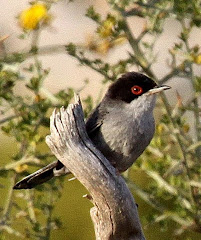
November 1 2011:
This bird at Kynnersley was first seen two days earlier and initially thought to be a Great Grey Shrike. Closer views by the finders led to it being revised to a Steppe Grey Shrike, i.e. a subspecies (pallidirostris) of the Southern Grey Shrike. These are birds of Central Asia and very rare visitors to Britain, this one being well off-course. The previous record was in Lincolnshire three years ago (see below).


It had set up its feeding territory on rather remote agricultural land where it worked along a 500 metre stretch of sparsely vegetated hedgerow adjacent to a recently ploughed field. The bird was always remote to view, never coming within 200 metres and was often double this distance; this consequently made photography very difficult although there were good views through the 'scope. Today, in beautifully warm sunny weather, it perched at several favoured points along the hedge, sometimes on the tips of shrubs in true shrike-like fashion, and would drop down to the ploughed field whenever prey was spotted. It was a very light-grey coloured bird with a noticeably pale beak and a shortish distinctive dark mask. Its contrasting black and white tail feathers and white wing patches showed up well when in flight.


[Photo very close to #16-l, p.66, in 'Shrikes' (Lefranc & Worfolk, 1997)]


[The locality favoured by the Shrike: the long sparse hedgerow alongside the ploughed field]
There was always at least 10-15 people watching the bird at any one time with others constantly coming and going. Donations for car parking would no doubt eventually amount to a tidy sum.

[A few of the watchers]
It was a much more wary bird than the Lincolnshire one seen in 2008. That would happily fly to within a few feet and perch on telescopes or people's heads (see below).

[The very confiding Steppe Grey Shrike at Grainthorpe Haven in Lincolnshire in 2008]





















.jpg)



